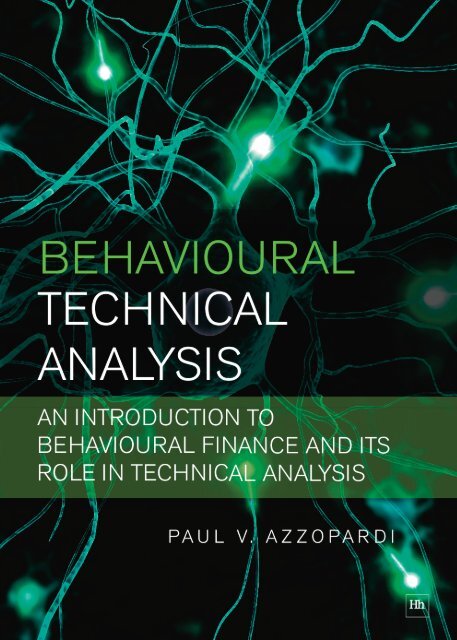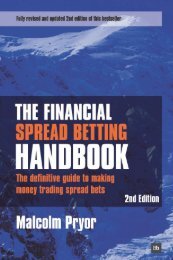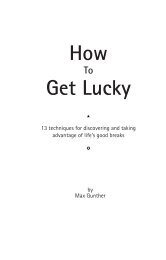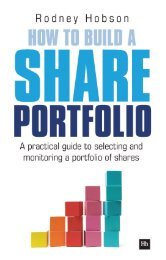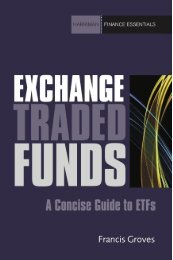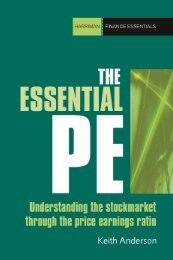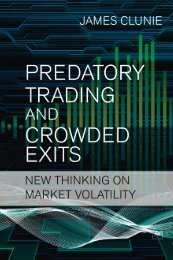Read a PDF Sample of Behavioural Technical ... - Harriman House
Read a PDF Sample of Behavioural Technical ... - Harriman House
Read a PDF Sample of Behavioural Technical ... - Harriman House
You also want an ePaper? Increase the reach of your titles
YUMPU automatically turns print PDFs into web optimized ePapers that Google loves.
xxxxxxxxxxxxxxxx<br />
1
• • • • <strong>Sample</strong> • • • •
<strong>Behavioural</strong> <strong>Technical</strong> Analysis<br />
An introduction to behavioural finance and its role in<br />
technical analysis<br />
By Paul V. Azzopardi
HARRIMAN HOUSE LTD<br />
3A Penns Road<br />
Petersfield<br />
Hampshire<br />
GU32 2EW<br />
GREAT BRITAIN<br />
Tel: +44 (0)1730 233870<br />
Fax: +44 (0)1730 233880<br />
Email: enquiries@harriman-house.com<br />
Website: www.harriman-house.com<br />
First published in Great Britain in 2010 by <strong>Harriman</strong> <strong>House</strong>.<br />
Copyright © Paul V. Azzopardi<br />
The right <strong>of</strong> Paul V. Azzopardi to be identified as the author has been asserted<br />
in accordance with the Copyright, Design and Patents Act 1988.<br />
978-1-905641-41-3<br />
British Library Cataloguing in Publication Data<br />
A CIP catalogue record for this book can be obtained from the British Library.<br />
All rights reserved; no part <strong>of</strong> this publication may be reproduced, stored in a retrieval<br />
system, or transmitted in any form or by any means, electronic, mechanical,<br />
photocopying, recording, or otherwise without the prior written permission <strong>of</strong> the<br />
Publisher. This book may not be lent, resold, hired out or otherwise disposed <strong>of</strong> by way<br />
<strong>of</strong> trade in any form <strong>of</strong> binding or cover other than that in which it is published without<br />
the prior written consent <strong>of</strong> the Publisher.<br />
Printed in the UK by the CPI Group Antony Rowe, Chippenham<br />
No responsibility for loss occasioned to any person or corporate body acting or<br />
refraining to act as a result <strong>of</strong> reading material in this book can be accepted by the<br />
Publisher, by the Author, or by the employer <strong>of</strong> the Author.<br />
Designated trademarks and brands are the property <strong>of</strong> their respective owners.
To Warren Paul and Marie Claire
Disclaimer<br />
The information, analysis and strategies discussed in this book are provided for<br />
informational and education purposes only and should not be considered to be<br />
investment advice.<br />
<strong>Read</strong>ers should do their own independent research and seek pr<strong>of</strong>essional advice<br />
before investing.<br />
<strong>Read</strong>ers should understand that there is a high degree <strong>of</strong> risk involved in trading<br />
securities and other financial instruments.<br />
Facts mentioned in this book should be re-checked against <strong>of</strong>ficial sources before<br />
investing.<br />
v
Contents<br />
Acknowledgements<br />
Preface<br />
ix<br />
xi<br />
PART ONE – BACKGROUND 1<br />
Chapter One – The <strong>Behavioural</strong> Finance Revolution 3<br />
Chapter Two – People Acting Strange: Emotion In Decision Making 15<br />
PART TWO – BEHAVIOURAL FINANCE 27<br />
Chapter Three – Complexity: Trying To Keep Things Simple 29<br />
Chapter Four – Perception: What You See Is Not Always What You Get 41<br />
Chapter Five – The Self: Tuum Est 67<br />
Chapter Six – Aversion: Pursuing Pleasure And Avoiding Pain 81<br />
Chapter Seven – Society: The Sentiment Of Crowds 101<br />
Chapter Eight – Gender 119<br />
PART THREE – BEHAVIOURAL FINANCE AND TECHNICAL ANALYSIS 131<br />
Chapter Nine – <strong>Behavioural</strong> Aspects Of <strong>Technical</strong> Analysis 133<br />
Chapter Ten – New Horizons 165<br />
Appendices 173<br />
Appendix One – Rational Economic Man 175<br />
Appendix Two – Table Of Biases 181<br />
Appendix Three – MTP Checklist 185<br />
References 189<br />
Index 197<br />
vii
Acknowledgements<br />
The people who have helped with this book, directly or indirectly, are numerous and<br />
listing them all would be tedious (and generally meaningless) to the reader. But a<br />
few persons, in my life and in this project, stand above all the rest.<br />
To my parents, Joseph and Pauline, and to my grandparents, Paul and Mary Grace<br />
Sammut, I owe oceans <strong>of</strong> gratitude for their love, good example and for always<br />
encouraging me to seek knowledge.<br />
To my wife, Jennifer, invariably a source <strong>of</strong> encouragement and enthusiasm but<br />
always with an eye on an even keel.<br />
To my project editor at <strong>Harriman</strong> <strong>House</strong>, Stephen Eckett, who has not only been<br />
patient and supportive over many months but who also did his best to make sure I<br />
wrote the book for others, not myself.<br />
I would like to thank my readers for choosing to read this book. I hope you enjoy<br />
reading it as much as I enjoyed writing it.<br />
If you have any comments or suggested improvements please email me at<br />
email@paulvazzopardi.com.<br />
I have set up a website at www.behaviouraltechnicalanalysis.com to provide relevant<br />
links for this book, supporting material and occasional articles.<br />
Paul V. Azzopardi<br />
Ontario, Canada<br />
ix
Preface<br />
In a sense, investors are be seen as living a life-long struggle against the randomness<br />
<strong>of</strong> market prices. For my part, I tried to make some sense <strong>of</strong> these utterly capricious<br />
but captivating markets by first becoming a certified accountant, in order to learn<br />
the language <strong>of</strong> business, and later immersing myself in as much investment theory<br />
as I could.<br />
I therefore started from the trenches <strong>of</strong> fundamentals and was soon led to the<br />
mathematically elegant boulevards <strong>of</strong> efficient markets, the capital asset pricing<br />
model and option pricing theories. I found lots <strong>of</strong> stimuli but little satisfaction.<br />
For quite a long while I compromised and worked on the assumption that if I did my<br />
homework and got the basics <strong>of</strong> the fundamentals right, I could then join the market<br />
with a diversified portfolio, watch over it, and hope for the best. I tried to improve<br />
on this basic setup with stop loss levels and, strategically, by trying to guess the next<br />
move. It sort <strong>of</strong> worked, on average, but I was far from happy with the results.<br />
It was when I first read Reminiscences <strong>of</strong> a Stock Operator, Edwin Lefèvre’s<br />
masterpiece based on the life <strong>of</strong> Jesse Livermore, that I realised fundamentals had a<br />
role to play – but not the role – and that the market had to be seen as having a life<br />
<strong>of</strong> its own, fuelled by sentiment. I realised that it was sentiment that made the market<br />
move and that this movement was evident in the footprints <strong>of</strong> price. Sentiment,<br />
furthermore, was nothing more than the collective psychology <strong>of</strong> the participants in<br />
the market. This potpourri <strong>of</strong> fundamentals, footprints and sentiment had to<br />
somehow show me the way.<br />
At about the same time, in various articles, I came across references to Kahneman<br />
and Tversky’s work on prospect theory and how they proposed that people <strong>of</strong>ten<br />
made use <strong>of</strong> rules <strong>of</strong> thumb, so-called heuristics, to make decisions in uncertain<br />
conditions. They were writing about such concepts as representativeness,<br />
availability, anchoring and adjustment. And what was I, and many other investors,<br />
doing if not deciding under uncertainty? Kahneman and Tversky’s behavioural<br />
finance approach was using up-to-the-minute research techniques, drawn from<br />
psychology, economics, statistics and various other disciplines to try to get to the<br />
bottom <strong>of</strong> Livermore’s market psychology. I felt this work went to the heart <strong>of</strong> the<br />
markets and I was hooked.<br />
Decision making lies at the heart <strong>of</strong> investing and behavioural finance describes how<br />
people decide – it was clear to me that behavioural finance should be a core<br />
investment discipline. It also soon became evident to me that while fundamentals<br />
dealt with the day after tomorrow (if fed good data), I could only know what was<br />
happening now and what was likely to happen tomorrow by looking at price<br />
patterns on graphs. This led me to the realisation that sentiment and price patterns<br />
xi
<strong>Behavioural</strong> <strong>Technical</strong> Analysis<br />
have to be observed most closely, with fundamentals and economic models as<br />
background. One other crucial thing is to collect evidence with statistics and<br />
quantitative techniques to make sure it is fact, and not myth, which is being studied.<br />
This re-focus changed my whole approach to investment.<br />
As the turn <strong>of</strong> events in 2008 and 2009 showed, the nature <strong>of</strong> the market is that no<br />
one can have perpetual success and that each person involved in the markets is on<br />
the way to learning more. I hope, however, that this re-focus helps my readers to<br />
improve their performance as it helped me to improve mine.<br />
The rise <strong>of</strong> behavioural finance<br />
I am very pleased to note that technical analysis associations around the world are<br />
increasingly including market sentiment and investor psychology studies in their<br />
approved body <strong>of</strong> knowledge and course curricula as well as giving greater<br />
importance to evidence validated by statistical testing. Papers dealing with the<br />
behavioural finance aspects <strong>of</strong> technical analysis now feature in important<br />
conferences and awards.<br />
Influential bodies such as the Market Technicians Association (USA), the Society <strong>of</strong><br />
<strong>Technical</strong> Analysts (UK), the Canadian Society <strong>of</strong> <strong>Technical</strong> Analysts, the Australian<br />
<strong>Technical</strong> Analysts Association and the <strong>Technical</strong> Analysts Society (Singapore), as<br />
well as other similar associations around the world, are proactively including<br />
behavioural finance findings in approved research.<br />
The <strong>Technical</strong> Analyst magazine in the UK, for example, regularly holds conferences,<br />
training and other events, and has started a series <strong>of</strong> behavioural finance seminars<br />
for “traders and investment managers looking to exploit market inefficiencies using<br />
market psychology.” The 2008 seminar included speakers on prospect theory, overand<br />
under-reaction, herding and using behavioural finance in value investing. These<br />
and similar initiatives around the world augur new horizons in finance and securities<br />
trading which have the potential to transform the way we approach markets.<br />
Firms providing investor relations services are now analysing shareholders not only<br />
by type (institution, mutual fund, individual, etc) but also by style <strong>of</strong> investment<br />
management and whether there are buy-side or sell-side pressures amongst different<br />
shareholding classes. <strong>Behavioural</strong> finance, therefore, is influencing not only<br />
investment decision making but also the relationships between corporations and<br />
their owners.<br />
xii
Preface<br />
The objectives <strong>of</strong> this book<br />
This book has three main objectives. My first objective is to introduce behavioural<br />
finance to investors in a practical, interesting and structured manner. After the<br />
introductory Part One, giving some background to behavioural finance, in Part Two<br />
I have presented the main concepts <strong>of</strong> behavioural finance so that the reader is<br />
provided with a grounding in the whole subject area.<br />
My second objective, as important as the first, is to try and give some pointers as to<br />
how one might attempt to combine the rapidly developing but rather new field <strong>of</strong><br />
behavioural finance with the insights <strong>of</strong>fered by technical analysis, which has been<br />
around ever since markets as we know them began to take shape. This combination<br />
I call behavioural technical analysis.<br />
I feel that the mutual pollination <strong>of</strong> behavioural finance and technical analysis can<br />
lead to new and stimulating vistas. I hope that the logic <strong>of</strong> fusing the two disciplines,<br />
and testing the hypotheses generated with objective observation and modern<br />
quantitative techniques, will provide impetus to further research in this area and,<br />
importantly, create new ways <strong>of</strong> making money.<br />
My third objective is that this book be <strong>of</strong> practical value to the investor, helping<br />
them to find a way to make money. This book does not contain a secret formula<br />
which enables you to acquire great wealth on the market in a few months by<br />
dedicating a few minutes a day. Instead, at the end <strong>of</strong> each chapter in Part Two there<br />
is a summary section, discussing how the behavioural finance area just explored can<br />
be used by investors. This is extended further in Part Three, where I examine the<br />
behavioural finance concepts supporting three strategies which technical analysts<br />
have utilised over the years. The three strategies are extreme prices, trend following,<br />
and support and resistance. I chose these three strategies because they are well<br />
supported by the evidence and <strong>of</strong>fer good prospects for pr<strong>of</strong>itable trading in<br />
securities.<br />
xiii
PART ONE<br />
BACKGROUND
Chapter One<br />
The <strong>Behavioural</strong> Finance Revolution<br />
“There is nothing so dangerous as the pursuit <strong>of</strong> a rational investment policy<br />
in an irrational world.”<br />
John Maynard Keynes
What this chapter is about<br />
This chapter shows why behavioural finance is important. Classical economics, on<br />
which most <strong>of</strong> our investment knowledge is based, relied on the concept <strong>of</strong> rational<br />
economic man: a calculating, unemotional participant with a perfect understanding<br />
<strong>of</strong> things around him. <strong>Behavioural</strong> finance challenged this assumption and broke the<br />
classical model, developing new, practical ideas that were more realistic.<br />
This chapter introduces six categories which facilitate our approach to behavioural<br />
finance, each the subject <strong>of</strong> a subsequent chapter, and deals briefly with how<br />
behavioural finance can be combined with other investment disciplines.<br />
Why is behavioural finance important for your investments?<br />
Investment is a decision-making process based on the analysis <strong>of</strong> data and a<br />
judgement on risk and uncertainty. Our human nature – be it our emotional side, our<br />
brain, or even our physiology – plays an important part in this decision-making<br />
process. <strong>Behavioural</strong> finance studies how people make financial decisions and the<br />
strength and weaknesses their human nature brings to the table. <strong>Behavioural</strong><br />
finance, therefore, lies at the centre <strong>of</strong> the investment process and it has provided<br />
investors with new insights into how to invest their money.<br />
The way we look at financial decisions today is very different from how we looked at<br />
them even as little as ten years ago. <strong>Behavioural</strong> finance has taken the old theories <strong>of</strong><br />
economics and finance and re-examined them in the light <strong>of</strong> what psychology and<br />
other studies <strong>of</strong> human behaviour have taught us about the way human beings actually<br />
act and react – and not how they are supposed to act and react. Most <strong>of</strong> the pioneers<br />
<strong>of</strong> behavioural finance, therefore, were psychologists and behavioural scientists who<br />
applied their knowledge to human beings as economic agents and investors.<br />
One important assumption made by classical economists was that human beings<br />
were entirely rational in their economic behaviour. It was assumed that humans<br />
analysed everything in a dispassionate and logical manner and only transacted when<br />
it was in their interest. Not only this, but it was also assumed that these cold<br />
calculations took place against a background <strong>of</strong> perfect information and,<br />
furthermore, were made in such a manner as to optimise the benefit derived by<br />
whoever was making the transaction.<br />
Most <strong>of</strong> classical economics, therefore, was based on the concept <strong>of</strong> the so-called<br />
rational economic man, or REM. The subjects <strong>of</strong> finance and investment are but<br />
specialisations <strong>of</strong> economics and it is therefore no wonder that financial researchers<br />
first built upon the economic theories that were at hand when they did their work.<br />
These early finance theories are <strong>of</strong>ten referred to by behavioural finance<br />
practitioners as standard finance.<br />
5
<strong>Behavioural</strong> <strong>Technical</strong> Analysis<br />
================<br />
The REM<br />
Rational economic man – a calculating, logical, and emotionless being – was the<br />
bedrock <strong>of</strong> many economic models which were built in the early years <strong>of</strong> economics.<br />
Suppose the REM wants to buy a car. He might go about it in various ways but is likely<br />
to go something like this. He realises he needs to buy the best car for the least costs.<br />
He first makes a list <strong>of</strong> the reasons why he needs a car: to travel to work, go to the<br />
cinema, go to the big shopping malls in the suburbs, etc. He then calculates the<br />
benefits he is likely to derive from having his own car rather than using public<br />
transport, hiring a car on a need basis, calling a taxi, or asking for a lift. Once he has<br />
calculated the monetary value <strong>of</strong> the benefit he is likely to derive, he then goes about<br />
looking at the costs.<br />
He realises he needs to collect information about the different cars on <strong>of</strong>fer and he<br />
makes a list <strong>of</strong> all the car vendors in the world. He examines this list and decides that<br />
the costs <strong>of</strong> going to another continent to buy a car are likely to prove prohibitive. He<br />
then decides on an appropriate radius in which procurement can reasonably take place.<br />
He collects information on all the cars: prices, delivery times, likely maintenance costs,<br />
taxes and duties payable, fuel consumption, cost <strong>of</strong> licences, costs <strong>of</strong> insurance, etc. He<br />
then calculates how long he can use each car for and the disposal value <strong>of</strong> the car at<br />
the end <strong>of</strong> the period. He then compares the benefits he is likely to derive with the<br />
bottom line cost <strong>of</strong> each model <strong>of</strong> each make. By the time he makes a decision as to<br />
which car to choose he would have worked himself up to be a great expert on cars: he<br />
would have near perfect information and his choice is a sharp-pencilled one.<br />
================<br />
Does REM exist?<br />
Mr REM is really a caricature. Hopefully very few people behave in this obsessive<br />
way when they come to buy a car. Mr REM’s approach and methods are too timeconsuming<br />
and, indeed, it is probably a never-ending exercise because by the time<br />
Mr REM starts to get somewhere most <strong>of</strong> his original data is obsolete. If we were to<br />
make decisions the REM way, we would probably never arrive at any conclusion.<br />
Yet, we know that there is some truth in my description <strong>of</strong> the REM. When buying<br />
a new car we ask ourselves whether we really need one, or whether we can go by<br />
public transport, especially if we live in a big city. We also want to know how much<br />
the car would cost us, about fuel efficiency, where best to get the car from and where<br />
are we likely to service it. The REM hypothetical model, therefore, is not accurate,<br />
but does contain some truth. It does mirror, in certain ways, the way we behave.<br />
6
The <strong>Behavioural</strong> Finance Revolution<br />
In the case under consideration, that <strong>of</strong> buying a car, we as normal human beings<br />
are likely to do two things differently from Mr REM. First, we are unlikely to do as<br />
much research, analysis and calculation as Mr REM did. We are likely to keep things<br />
much simpler, making fewer mental calculations and comparisons. Otherwise things<br />
would get too complex.<br />
Second, we are likely to look at various emotional factors associated with the car.<br />
The brand, top speed, the shape <strong>of</strong> the model, the colours available, and the cachet<br />
associated with the vehicle may be important factors to many drivers. To many, a<br />
motor car is not simply a machine, but is <strong>of</strong>ten nearly a living thing. A car then is<br />
more than the sum <strong>of</strong> its parts and its function is much more than simply taking<br />
people and things from point A to point B.<br />
It is no wonder that an economic model which treats cars as simply transportation<br />
machines would not reflect all the essential characteristics <strong>of</strong> the real world and<br />
would have, as a consequence, limited utility in describing what is happening and<br />
in predicting the future. In a similar fashion, a financial model based on REM does<br />
not capture many <strong>of</strong> the real life and critical aspects <strong>of</strong> the market it is trying to<br />
explain. 1<br />
The beginnings <strong>of</strong> behavioural finance<br />
In various ways, the car example brings us to the heart <strong>of</strong> behavioural finance.<br />
<strong>Behavioural</strong> finance pioneers realised that while REM was a powerful concept, one<br />
that allowed the building <strong>of</strong> various useful economic theories, it did not capture<br />
enough <strong>of</strong> the truth – it did not capture real human beings with all the emotional<br />
baggage and personality humans posses.<br />
We all know that our emotions, such as fear and greed, and the emotions <strong>of</strong> others,<br />
especially if we are part <strong>of</strong> a crowd, creep surreptitiously into our decision-making<br />
and nudge us <strong>of</strong>f the logical path. Often it is only with hindsight that we realise how<br />
carried away we actually were. “What was I thinking!” we exclaim when it is too late.<br />
<strong>Behavioural</strong> finance pioneers felt that economics had to be re-examined and refined<br />
placing real, <strong>of</strong>ten irrational, <strong>of</strong>ten emotional, sometimes capricious, men and<br />
women at the centre.<br />
So, behavioural finance can be said to be about the replacement <strong>of</strong> homo<br />
economicus, or REM, by homo sapiens, real man, in economics. This re-examination<br />
<strong>of</strong> the nature <strong>of</strong> human beings as economic agents led to important critiques <strong>of</strong><br />
economic theory by Daniel Kahneman, Amos Tversky, Robert Shiller, Richard Thaler<br />
and others, which laid the groundwork for the development <strong>of</strong> behavioural finance.<br />
1 Please see Appendix 1 for a brief discussion <strong>of</strong> REM in the market.<br />
7
<strong>Behavioural</strong> <strong>Technical</strong> Analysis<br />
Rational within limits<br />
Today, many researchers do not base their work on the superhuman rationality <strong>of</strong><br />
REM but make use <strong>of</strong> a more realistic concept, that <strong>of</strong> bounded rationality.<br />
This concept accepts that human beings are essentially rational and given to<br />
optimising behaviour but recognises that there are limits to the brain’s ability to<br />
assimilate and solve complex problems.<br />
<strong>Behavioural</strong> finance<br />
<strong>Behavioural</strong> finance is the application <strong>of</strong> psychology and other analytical<br />
tools to the behaviour <strong>of</strong> investors.<br />
One aspect <strong>of</strong> behavioural finance which makes it so fascinating is the study <strong>of</strong><br />
unexpected, illogical and counter-intuitive decision making. It is precisely this that<br />
gives the implications <strong>of</strong> behavioural finance such importance.<br />
Researchers are now going beyond the study <strong>of</strong> manifest decisions to explore the<br />
human brain in greater depth by means <strong>of</strong> Magnetic Resonance Imaging (MRI) and<br />
other new tools, seeking to understand the very processes whereby an individual<br />
arrives at his or her economic decisions. While brain studies continue to elucidate how<br />
people make up their minds it is perhaps sobering to note that, ironically, irrational and<br />
unpredictable decision-making is likely to always remain the prerogative <strong>of</strong> human<br />
beings. Without uncertainty there would be little scope for learning how to invest.<br />
Investors, for various psychological and physiological reasons, sometimes act<br />
illogically, succumb to emotion, make decisions by primitive rules <strong>of</strong> thumb, have a<br />
variable attitude towards risk, sometimes follow the crowd wherever it leads them,<br />
let fear or optimism take hold <strong>of</strong> them, and generally behave in such a way which<br />
shows that, after all, markets are all too human. In the next chapter, we shall<br />
examine some aspects <strong>of</strong> the irrationality <strong>of</strong> humans.<br />
The six categories <strong>of</strong> behavioural finance<br />
Psychology, unlike some <strong>of</strong> the other science disciplines, is not built around a unified<br />
theory. Instead, it is made up <strong>of</strong> a large number <strong>of</strong> theories, hypotheses and<br />
experimental results which are not tied together neatly in one grand framework and<br />
<strong>of</strong>ten seem disparate. <strong>Behavioural</strong> finance, borrowing so much from psychology,<br />
inherited its parent’s fragmented nature and this can be somewhat <strong>of</strong>f-putting to<br />
investors approaching the subject for the first time.<br />
8
The <strong>Behavioural</strong> Finance Revolution<br />
For this reason, I have classified behavioural finance topics into six main categories.<br />
This classification is rather tentative and there are inevitable overlaps but it is the<br />
best way I could devise <strong>of</strong> organising the subject so that an investor taking up this<br />
book can form a broad idea <strong>of</strong> what the main concerns <strong>of</strong> behavioural finance are.<br />
In this way, in his or her further reading, especially when perusing academic papers<br />
and the more technical books, the reader will have a rough-and-ready framework on<br />
which to hang the different observations and theories.<br />
There may be topics which fall between the six stools, so to speak, and, indeed, as<br />
behavioural finance develops, and its ken widens, there may be need for more (or<br />
fewer) categories.<br />
The categories<br />
The six main categories are, in turn, divided in two.<br />
First, there are the three categories which deal with our interactions with the world<br />
around us:<br />
1. Complexity: coping and dealing with the complexity around us;<br />
2. Perception: the role <strong>of</strong> perception and how it affects our behaviour;<br />
3. Aversion: our attempt to avoid emotional instability.<br />
Second, there are the three categories dealing with who we are and the influences <strong>of</strong><br />
those around us:<br />
4. Self: the influence <strong>of</strong> the self, including status quo;<br />
5. Society: the crowd <strong>of</strong> which we form part;<br />
6. Gender: behavioural patterns resulting from gender differences.<br />
I call this the CPA-SSG Framework.<br />
Figure 1.1: the CPA-SSG Framework<br />
Complexity<br />
Self<br />
Perception<br />
Aversion<br />
Society<br />
Gender<br />
9
<strong>Behavioural</strong> <strong>Technical</strong> Analysis<br />
Aversion is a very powerful concept in behavioural finance and fuses together<br />
various observations and important studies, including the work on prospect theory.<br />
For this reason, this book deals with aversion after it deals with the forces <strong>of</strong> the self.<br />
The chapters dealing with each category are therefore as follows:<br />
===========================<br />
The six categories <strong>of</strong> behavioural finance<br />
1. Coping and dealing with complexity: Chapter Three<br />
2. The role <strong>of</strong> perception: Chapter Four<br />
3. Aversion: Chapter Six<br />
4. The self: Chapter Five<br />
5. The crowd: Chapter Seven<br />
6. Gender issues: Chapter Eight<br />
===========================<br />
After looking at how emotions creep into our decision-making in Chapter Two, we<br />
look at the first category (Chapter Three), which groups together studies examining<br />
how human beings cope and deal with complexity. The world we live in is a complex<br />
place and the human brain has huge, but still limited, capabilities. Faced with the<br />
difficulties which the world – and the marketplace – present, the brain does what it<br />
can. It therefore tries to simplify, uses rules <strong>of</strong> thumb, thinks and observes selectively,<br />
looks for patterns and creates its own blind spots.<br />
One fascinating way in which the brain tries to cope is by focusing on changes<br />
rather than stationary states. As we shall see, the fact that our brain is better at<br />
seeing changes rather than constant states places a limit on our rationality – we<br />
normally place more importance on what we gain or lose rather than on what we<br />
have.<br />
My second category (Chapter Four) deals with the role <strong>of</strong> perception in behavioural<br />
finance. As any painter would tell you, we do not see what is there but what we<br />
think is there. Indeed, the most difficult part <strong>of</strong> becoming a realist painter is learning<br />
to see what is actually there – not what is usually there, not what photographs say<br />
is there and not what one supposes to be there.<br />
The same is true in most academic training: one is learning how to research, how to<br />
measure properly, how to be logical, how to detect and remove subjectivity. The<br />
human brain has a tendency to see what it wants to see, bands people and events<br />
together in a rough-and-ready manner by prototype, gives undue importance to the<br />
10
The <strong>Behavioural</strong> Finance Revolution<br />
most recent events rather than the truly important events, comes to conclusions<br />
based on hindsight and values data depending on how it is framed. Accountants<br />
knew this all along. This is the reason why accounting standards place such a lot <strong>of</strong><br />
importance on how data is classified, how information is presented and what is<br />
material or not.<br />
The third category (Chapter Six) groups behaviour which is driven by aversion. We<br />
need stability and to “know where we stand”. As a general rule, humans do not want<br />
frequent change – stability is desirable. Financially, for example, we try to avoid<br />
having frequent changes in the value <strong>of</strong> our portfolio. Up 25% one day and down<br />
20% the following day spells too much adrenalin in too short a time. That’s the<br />
general rule, though, since sometimes we actively go out and seek adventure, and<br />
take a punt on life.<br />
The self is the subject <strong>of</strong> the fourth category (Chapter Five). What we see and what<br />
we do depends on who we are. We may be naturally pessimistic, optimistic,<br />
conservative, self-critical, or even given to magical thinking: all <strong>of</strong> these affect the<br />
way we perceive the world, and the way we behave.<br />
For example, if an individual is overconfident, the way they see the market and the<br />
way they transact will show this. This is one reason why many investors exclaim<br />
that their luck turns bad when they stop paper trading and start the real thing. When<br />
paper trading and using notional money investors have less emotional involvement<br />
than when using real money. They are less anxious and perhaps more logical. Once<br />
they start using real money, they become hesitant, emotional rather than logical, and<br />
their trading suffers. This is the main reason why one should start real trading on a<br />
small scale. A good deal <strong>of</strong> becoming a successful trader involves training oneself to<br />
gain poise, to act dispassionately in a detached manner and to avoid getting<br />
emotionally involved.<br />
We are nearly always part <strong>of</strong> the crowd, part <strong>of</strong> society. The fifth category, therefore,<br />
which is dealt with in Chapter Seven, seeks to draw together how society influences<br />
the way we think and the way we feel. As time goes on, more evidence is emerging<br />
that our linkages to those around us are wired into our brain. We <strong>of</strong>ten observe how<br />
people who live for a long time together start to think and speak in similar ways;<br />
some say they start to look the same as well.<br />
Chapter Seven also examines how society’s feelings and beliefs feed upon<br />
themselves and <strong>of</strong>ten spiral out <strong>of</strong> control. These beliefs are <strong>of</strong>ten, <strong>of</strong> course, backed<br />
by money and therefore have an influence on markets. As investors, we should be<br />
aware <strong>of</strong> these beliefs and expectations which have taken hold <strong>of</strong> a market and seek<br />
to pr<strong>of</strong>it from them, either by going long as a movement starts to develop or by<br />
going short when we think it is past its peak. We <strong>of</strong>ten observe that once a<br />
movement starts, it tends to last longer than many people expect.<br />
11
<strong>Behavioural</strong> <strong>Technical</strong> Analysis<br />
At the end <strong>of</strong> Part Two the sixth category deals with gender issues (Chapter Eight).<br />
Classical economics and finance did not consider the gender <strong>of</strong> the persons making<br />
investment decisions but behavioural finance shows that gender is a critical variable<br />
because men and women have different attitudes towards investing. Men, for<br />
example, tend to be overconfident while women are generally conservative. This is<br />
a very wide area <strong>of</strong> research, and work has just begun, but it is likely that investor<br />
pr<strong>of</strong>iling, especially gender, will become a major issue in future. Gender differences<br />
highlight the usefulness <strong>of</strong> technical analysis in providing a more objective approach<br />
to investing.<br />
In Part Three we focus more on how behavioural finance can be combined with<br />
technical analysis and quantitative finance to forge a new approach to the market.<br />
In Chapter Nine a conceptual framework for understanding three tools <strong>of</strong> technical<br />
analysis – extreme prices, trends, and support and resistance – is introduced and the<br />
relevant behavioural finance concepts behind each part <strong>of</strong> this framework are<br />
discussed. Chapter Ten, the final chapter, looks briefly at the new horizons which are<br />
opening up and how readers can best put this book to practical use.<br />
The fourth approach<br />
For a long time, writers on investments have spoken <strong>of</strong> two main approaches to<br />
investing.<br />
First, there is the fundamental approach. A security – be it a share in a company or<br />
bonds issued by the state – is analysed in terms <strong>of</strong> its economic characteristics and<br />
value. If we are analysing a share in a company, for example, we would ask<br />
questions such as:<br />
• What are the pr<strong>of</strong>its <strong>of</strong> the company after tax?<br />
• How many shares does this company have in issue?<br />
• What are the pr<strong>of</strong>its as a percentage <strong>of</strong> turnover?<br />
• Are turnover and pr<strong>of</strong>its increasing, stable or declining? Why?<br />
• What is the edge <strong>of</strong> the company in the market?<br />
• What is the market share <strong>of</strong> the company?<br />
• What are the strengths, weaknesses, opportunities <strong>of</strong> the company and what<br />
threats does it face (so-called SWOT analysis)?<br />
• What debt level does the company have and is this level sustainable?<br />
• What dividend does the company distribute?<br />
12
The <strong>Behavioural</strong> Finance Revolution<br />
Questions such as these help us gain an understanding <strong>of</strong> the company, and its likely<br />
future cash flows, and thus we can arrive at an idea <strong>of</strong> its value.<br />
The second approach is technical analysis. In technical analysis, it is primarily the<br />
price <strong>of</strong> the share that is examined, <strong>of</strong>ten in the context <strong>of</strong> the market. Analysts look<br />
at how the price <strong>of</strong> the share changed over time and whether the volume <strong>of</strong> shares<br />
transacted was supportive <strong>of</strong> the trend in price. Specific patterns are considered, for<br />
example the head and shoulders formation, as indicative <strong>of</strong> a change in trend and<br />
others – such as flags – are taken to indicate a continuation <strong>of</strong> the trend. Simple and<br />
moving averages, and the difference between moving averages <strong>of</strong> different time<br />
periods, are also used. It is assumed that by studying price and volume patterns it is<br />
possible to predict how the price will change.<br />
Eventually, a third approach, or analytical dimension, emerged; quantitative<br />
analysis. Economists took a more universal look at the market and in their new<br />
models included all the assets in the world and assumed that participants in this<br />
market had good information on which to make decisions. They applied various<br />
statistical and mathematical tools to these models <strong>of</strong> the capital market. The<br />
quantitative approach gained prominence in the late 1970s and with it came the<br />
various influential models we have today, including the capital asset pricing model<br />
and the various models used to value options. New tools were developed as<br />
mathematics and statistics were more frequently applied to models <strong>of</strong> the market, as<br />
economists analysed the market to gather evidence to confirm or refute hypotheses<br />
and as new quantitative techniques, such as GARCH and fractal geometry, evolved.<br />
Some writers include quantitative finance with the fundamental approach but many<br />
writers on technical analysis contend that quantitative finance is actually just a<br />
development <strong>of</strong> their work on price movements and markets. Whatever the<br />
classification considerations involved, none <strong>of</strong> the three approaches really placed the<br />
individual investor’s psychology at the very centre <strong>of</strong> its considerations. The<br />
individual investor was obviously there but he or she was generally assumed to be<br />
behaving as expected; that is rationally. It was behavioural finance which made<br />
investors’ psychology and behaviour the focus <strong>of</strong> its studies. In this sense, therefore,<br />
behavioural finance can be seen as the much needed fourth approach to investment.<br />
13
<strong>Behavioural</strong> <strong>Technical</strong> Analysis<br />
Key concepts in this chapter<br />
• Rational economic man – too ideal a construct<br />
• Bounded rationality – a better model<br />
• The six categories <strong>of</strong> behavioural finance, the CPA-SSG Framework:<br />
• Dealing with Complexity<br />
• Problems <strong>of</strong> Perception<br />
• Aversion <strong>of</strong> instability<br />
• The Self<br />
• Society<br />
• Gender<br />
• Investing:<br />
• Fundamental approach<br />
• <strong>Technical</strong> analysis<br />
• Analytical/quantitative approach<br />
• The fourth dimension – behavioural finance<br />
14
<strong>Behavioural</strong> <strong>Technical</strong><br />
Analysis<br />
An introduction to behavioural finance and<br />
its role in technical analysis<br />
Paul V. Azzopardi<br />
Available direct from <strong>Harriman</strong> <strong>House</strong> and all good booksellers. To order<br />
a copy <strong>of</strong> the print or ebook edition go to:<br />
www.harriman-house.com/behaviouraltechnicalanalysis<br />
Paperback: 9781905641413<br />
eBook: 9780857190680


